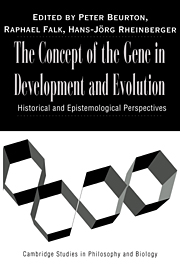Book contents
- Frontmatter
- Contents
- Introduction
- List of Authors
- PART ONE GENES AND TRAITS
- PART TWO EXTRACTING THE UNITS OF HEREDITY
- 4 From Measurement to Organization: A Philosophical Scheme for the History of the Concept of Heredity
- 5 From Gene to Genetic Hierarchy: Richard Goldschmidt and the Problem of the Gene
- 6 Seymour Benzer and the Definition of the Gene
- PART THREE GENETIC PROGRAMS AND DEVELOPMENTAL GENES
- PART FOUR CONCEPTUAL PERSPECTIVES
- FINAL REVIEW
- Glossary
- Index
4 - From Measurement to Organization: A Philosophical Scheme for the History of the Concept of Heredity
from PART TWO - EXTRACTING THE UNITS OF HEREDITY
Published online by Cambridge University Press: 12 January 2010
- Frontmatter
- Contents
- Introduction
- List of Authors
- PART ONE GENES AND TRAITS
- PART TWO EXTRACTING THE UNITS OF HEREDITY
- 4 From Measurement to Organization: A Philosophical Scheme for the History of the Concept of Heredity
- 5 From Gene to Genetic Hierarchy: Richard Goldschmidt and the Problem of the Gene
- 6 Seymour Benzer and the Definition of the Gene
- PART THREE GENETIC PROGRAMS AND DEVELOPMENTAL GENES
- PART FOUR CONCEPTUAL PERSPECTIVES
- FINAL REVIEW
- Glossary
- Index
Summary
ABSTRACT
This paper proposes a general scheme for the historical analysis of the concept of heredity covering the last one and a half centuries. During this period heredity became a major biological concept that was purposefully subjected to experimental and quantitative methods of investigation. The conclusions drawn here are twofold. First, there were basically two alternative quantitative approaches to heredity: Either treat heredity in terms of a magnitude similar to the concepts of the physical sciences, or treat it as a material structure. After some initial pending and leaning toward the first alternative, biologists became increasingly committed to the second alternative. Second, I show that the three major phases in the history of the science of heredity (biometry, Mendelian genetics, and molecular genetics) corresponded to three quasi-explicit conceptions of the cognitive status of scientific theories, namely: phenomenalism, instrumentalism and realism. This periodization does not pretend to account for the entire complexity of the history of biological conceptions of heredity. These should be taken, rather, as ideal types that shed some light on important philosophical aspects of the broad history of the science of heredity.
INTRODUCTION
According to a common understanding among physicists, the concepts of a scientific theory consist fundamentally of magnitudes. Mass or force, for instance, have the status of quantitative concepts or magnitudes. Duhem (1981 [1914], chapter 2) proposed that the definition of magnitudes and their measurement was the first of four successive steps in the formation of a physical theory.
- Type
- Chapter
- Information
- The Concept of the Gene in Development and EvolutionHistorical and Epistemological Perspectives, pp. 69 - 90Publisher: Cambridge University PressPrint publication year: 2000
- 23
- Cited by



